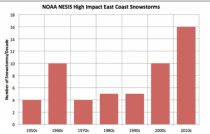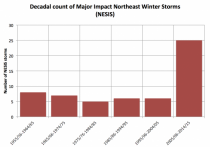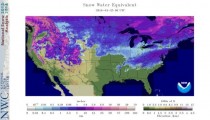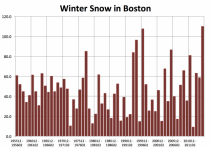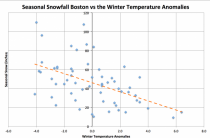Joseph D’Aleo, CCM
There has been a lot of buzz about the mammoth snowstorm in the media.
Predictably, there is talk this is the result of global warming. They forget the IPCC, UCS and NOAA in their reports for the EPA had stated winters were becoming warmer and less snowy especially in the major metropolitan areas where they historically lie near the critical thermal parameters near the rain versus snow boundary.
See fact check on UCS report.
Instead, the major cities have been blitzed with heavy snows this century.
The last decade through last winter has amazed with 25 NESIS storms (add a new one this year...more to come).
The fact is the snows occur in colder regimes. December was warm and SNOWLESS. It turned colder this month and POW.
Central Park NYC recorded 26.8“, 2nd behind 26.9” in 2006. This was more than the 25.1” whole season average. Philadelphia recorded 22.4”, which was the 6th heaviest in a two day period in records back to the 1870s, exactly the seasonal normal total. In the DC area, Baltimore had 29.2”, the most ever for a single storm, Dulles Airport had 29.3”, second to the February 2010 blizzard.
The last few years were cold in the northeast for January to March (2015 the coldest and 2014 the 11th coldest in the northeast since 1895) and record 2014/15 the snowiest on record in places.
Enlarged
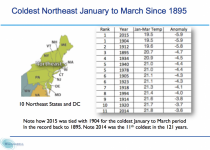
Snow is favored in COLD winters and increases with cooling not warming. In the 39 days last winter when Boston had 100.2 inches of snow, the melted precipitation was 5.69 inches, a ratio of 17.6 to 1. Seasonal snows are high in cold winters, low in warmer winters.
This has support in a new Journal of Climate story in phys.org that shows shows global warming would decrease contrast and extremes.
Extreme winters like we saw in Europe 2008-2013 and in the US the past few years are not due to claimed man made ‘warming’.
CLIMATE CHANGE DOES NOT CAUSE EXTREME WINTERS, NEW STUDY SHOWS
PHYS.ORG
March 27, 2015

Credit: Larisa Koshkina/public domain
Excerpts:
Cold snaps like the ones that hit the eastern United States in the past winters are not a consequence of climate change. Scientists at ETH Zurich and the California Institute of Technology have shown that global warming actually tends to reduce temperature variability.
Repeated cold snaps led to temperatures far below freezing across the eastern United States in the past two winters. Parts of the Niagara Falls froze, and ice floes formed on Lake Michigan. Such low temperatures had become rare in recent years. Pictures of icy, snow-covered cities made their way around the world, raising the question of whether climate change could be responsible for these extreme events.
It has been argued that the amplified warming of the Arctic relative to lower latitudes in recent decades has weakened the polar jet stream, a strong wind current several kilometres high in the atmosphere driven by temperature differences between the warm tropics and cold polar regions. One hypothesis is that a weaker jet stream may become more wavy, leading to greater fluctuations in temperature in mid-latitudes. Through a wavier jet stream, it has been suggested, amplified Arctic warming may have contributed to the cold snaps that hit the eastern United States.
Temperature range will decrease
Scientists at ETH Zurich and at the California Institute of Technology, led by Tapio Schneider, professor of climate dynamics at ETH Zurich, have come to a different conclusion. They used climate simulations and theoretical arguments to show that in most places, the range of temperature fluctuations will decrease as the climate warms. So not only will cold snaps become rarer simply because the climate is warming. Additionally, their frequency will be reduced because fluctuations about the warming mean temperature also become smaller, the scientists wrote in the latest issue of the Journal of Climate.
The study’s point of departure was that higher latitudes are indeed warming faster than lower ones, which means that the temperature difference between the equator and the poles is decreasing. Imagine for a moment that this temperature difference no longer exists. This would mean that air masses would have the same temperature, regardless of whether they flow from the south or north. In theory there would no longer be any temperature variability. Such an extreme scenario will not occur, but it illustrates the scientists’ theoretical approach.
Extremes will become rarer
Using a highly simplified climate model, they examined various climate scenarios to verify their theory. It showed that the temperature variability in mid-latitudes indeed decreases as the temperature difference between the poles and the equator diminishes. Climate model simulations by the Intergovernmental Panel on Climate Change (IPCC) showed similar results: as the climate warms, temperature differences in mid-latitudes decrease, and so does temperature variability, especially in winter.
Help us maintain Icecap if you are able. Even small amounts help us pay the maintenance charges for the server that keep coming each month. We keep the site going without a support staff to try and provide you with information you can use. We have over 8000 entries searchable - to help you find the information you need. Alternatively, consider a subscription to Weatherbell.





